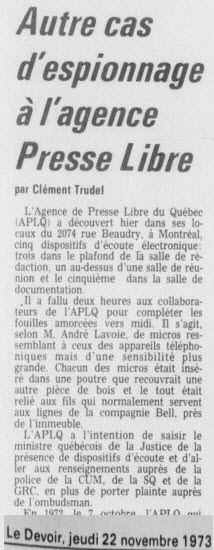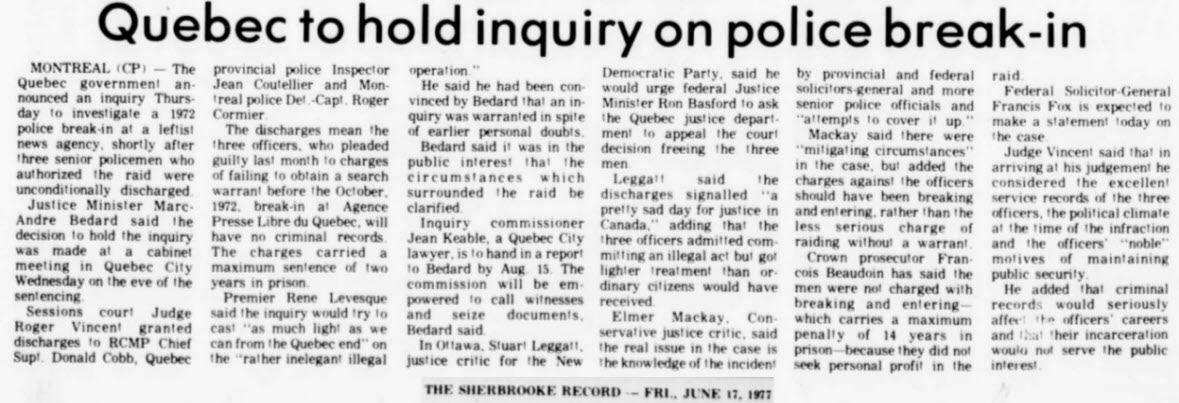Saturday morning, October 7, 1972, shortly after midnight, officers from the RCMP (Royal Canadian Mounted Police), the Quebec Provincial Police (SQ, Sûreté du Québec), and the Montreal City Police Service (SPCUM, Service de police de la Communauté urbaine de Montréal), broke and entered, a brick building, at 3459 Saint-Hubert, Montreal, and stole documents, belonging to, the Free Press Agency of Quebec (APLQ, Agence de Presse Libre du Québec), the Movement for the Defense of Political Prisoners in Quebec (MDPPQ, Mouvement pour la Défense des Prisonniers Politiques Québécois), and the Relocation cooperative of the 1st of May (Coopérative des déménagements du 1er mai).
Operation Bricole, which translates to Operation Tinker, was a disruptive tactic. The Keable inquiry report, cites Inspector Donald Cobb, who was then, Officer in Charge, of The G section in Montreal, created by the RCMP, to deal, with separatist movements, and terrorist activities, in Quebec:
In the aftermath of the 1970 crisis (by summer 1971), «g» section, had become prevention oriented.
We prevented, the much-mooted FLQ renaissance, of 1971, by a simple reversal, of our earlier policies — a reversal inspired, by the theories of dr. Gustav Morf, and others, about the group dynamics, of secret associations.
Instead of hoarding our intelligence, we gave it away, to individuals, identified as particularly susceptible, by our psychologist, among known, or suspected members, of emerging cells.
The cells in question, exaggerating the extent of our knowledge of them, dispersed, as if by magic.
Operation Bricole was aimed, to precipitate, the disintegration of the movements under surveillance, by stealing their documents, information gathering, and there was the hope, that the crime would be blamed on the Milice républicaine, a rightwing separatist movement, leading to disarray between left and right. André Maheu, the leader of this group, some time before, tried in vain, to consult files, of the APLQ.

The APLQ, was founded, in March 1968, by two freelance journalists, Jacques Larue-Langlois, and Charles Meunier. The RCMP, believed, that these two journalists, were involved, with the FLQ.
In 1970, the two journalists, ceded the name, to a group of journalists, who published, since March 18, 1971, a weekly leftist bulletin, aimed to express the interests and demands, of workers and organizations, fighting, the current economic, and political system, especially, in Quebec.
The MDPPQ, was founded on 30 June 1970, by some 50 professors, activists and journalists, including, Mr Guy Marsolais, Dr Serge Mongeau, and the poet, Gaston Miron.
The main purpose, of this movement, was to raise funds, for the defense of people, perceived, because of their links, to the FLQ, as political prisoners.
The activities, of both the APLQ, and MDPPQ, were legal.
The MDPPQ, and APLQ, were under surveillance, by the RCMP, the SPCUM, and the SQ.
The police forces, had listening devices inside the APLQ premises, they tapped its line, and they had informers, inside the APLQ, and MDPPQ. Henri Lemyre, an informer, infiltrated the MDPPQ, and got a list of people, connected, to the MDPPQ.
After the break-in, the APLQ moved, to 2074 rue Beaudry, and on the 21 of November 1973, the APLQ, discovered five electronic listening devices, inside the building.

The policemen, responsible for watching the two movements, met, at Montreal Police headquarters. During the two months, of September and October 1972, operation Bricole, was planned.
Participated in the planning of the operation, possibly, more people have partaken:
- From the RCMP: Constable Robert Samson, Corporal Guy Bonsant, Sergeant Claude Brodeur.
- From the SQ: Constable Pierre Champagne, Corporal Richard Presseau, Corporal Hubert Reiter, Captain Léonce Guérard.
- From the SPCUM: Detective Sergeant Claude Marcotte, Detective Sergeant Fernand Tanguay, Detective Lieutenant Henri Marchessault, Detective Lieutenant Julien Giguère, Detective Lieutenant Roger Cormier.
On October 6, 1972, was the last meeting, before the operation.
Lieutenant Léonce Guérard, phoned Detective Inspector Jean Coutellier, Director of Security Services of the Sûreté du Québec, who authorized, the participation of the Quebec Provincial Police, in the operation.
Detective Lt. Roger Cormier, head of the Montreal Police intelligence department, authorized the participation, of the SPCUM.
Sergeant Claude Brodeur, telephoned Sergeant Henri Pelletier, head of section G-4, responsible for recruiting informers, and to infiltrate, separatist groups, to ask, if the RCMP, should continue with the operation, and it was Inspector Donald Cobb, who gave the authorization.
Constable Robert Bouchard, Detective Sergeants, Claude Marcotte, and Fernand Tanguay, from the SPCUM, Constable Robert Samson, from the RCMP, Constable Pierre Champagne, from the Sûreté du Québec, constituted the group, that broke and entered, into the building, on October 7, 1972.
This team, was helped by other teams, that provided surveillance, and other operations.
The stolen material, was taken, into the Montreal Police headquarters, and later, on the same day, was moved to the basement, of RCMP Sergeant, Claude Brodeur’s home, in Beloeil, Quebec, so that the police officers, can work, undisturbed.
The stolen documents, were analyzed, by the three police forces, involved in the operation, those of interest, were microfilmed, and the rest, was destroyed, in the Quebec Provincial Police, incinerator.
It was also decided, that the originals of documents, that have the possibility, of a future value, would be kept: The use that we could make of original documents, is to consolidate a suspicion, directed towards an individual, or a movement, or to discredit, an individual, or a movement… These documents, have the possibility of future value, from the point of view of counter-espionage, or the use of these documents, as a destructive measure…


The collected information, was transported, to RCMP headquarters, in Ottawa, to be used, by the three police forces.
RCMP reports, found, that the result of operation Bricole, were:
- the end of the MDPPQ's activities, it died shortly, after operation Bricole.
- APLQ activities, disrupted, for a period of time.
- introduced mistrust, which caused, the FLQ sympathizers, to be disorganized.
The APLQ, the MDPPQ and the Relocation cooperative of the 1st of May, after discovering the break-in, sent letters, to all three police forces, the Solicitor General of Canada, the Justice Minister of Quebec, and Quebec Ombudsman.
No replies were given, to the letters sent, to the three police forces, and the letter sent, to the Solicitor General of Canada. The Justice Minister of Quebec, and Quebec Ombudsman, denied the involvement of the police forces, in the operation.
March 8 1976, Robert Samson, and during his trial for a failed bombing, on the night of July 26, 1974, the bomb has exploded, while it was in his hands, revealed, that the APLQ break-in, was perpetrated, by the RCMP, the SQ, and the SPCUM.
The Solicitor General of Quebec, Fernand Lalonde, started an investigation, which resulted in Inspector Donald Cobb, from the RCMP, Inspector Jean Coutellier, from the Quebec Provincial Police, and Detective Lieutenant Roger Cormier, from the Montreal Police, being charged with authorizing a search, without obtaining, a search warrant.
The three policemen, pleaded guilty, during their trial, and on June 16 1977, Judge Roger Vincent, granted all three, unconditional discharges, and they returned, to active duty. The judge, described the police officers’ motives, as noble, said that the APLQ, was working against public security, and noted, the political climate, at the time.
On the same day, the Quebec government, announced the creation, of a provincial inquiry, under Quebec City lawyer, Jean Keable, to investigate, police activities.

In July 1977, Francis Fox, the Solicitor General of Canada, announced the creation, of a Royal Commission of Inquiry, to investigate, the illegal activities, of the Royal Canadian Mounted Police, after obtaining evidence, that the APLQ break-in, was not, an isolated case.